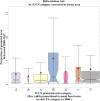A small subset of protected areas are a highly significant source of carbon emissions
- PMID: 28186155
- PMCID: PMC5301250
- DOI: 10.1038/srep41902
A small subset of protected areas are a highly significant source of carbon emissions
Abstract
Protected areas (PAs) aim to protect multiple ecosystem services. However, not all are well protected. For the first time, using published carbon and forest loss maps, we estimate carbon emissions in large forest PAs in tropical countries (N = 2018). We found 36 ± 16 Pg C stored in PA trees, representing 14.5% of all tropical forest biomass carbon. However the PAs lost forest at a mean rate of 0.18% yr-1 from 2000-2012. Lower protection status areas experienced higher forest losses (e.g. 0.39% yr-1 in IUCN cat III), yet even highest status areas lost 0.13% yr-1 (IUCN Cat I). Emissions were not evenly distributed: 80% of emissions derived from 8.3% of PAs (112 ± 49.5 Tg CO2 yr-1; n = 171). Unsurprisingly the largest emissions derived from PAs that started with the greatest total forest area; accounting for starting forest area and relating that to carbon lost using a linear model (r2 = 0.41), we found 1.1% outlying PAs (residuals >2σ; N = 23), representing 1.3% of the total PA forest area, yet causing 27.3% of all PA emissions. These results suggest PAs have been a successful means of protecting biomass carbon, yet a subset causing a disproportionately high share of emissions should be an urgent priority for management interventions.
Conflict of interest statement
The authors declare no competing financial interests.
Figures





References
-
- MacDicken K. et al.. Forest Resource Assessment 2015. How are the world’s forests changing? Second edition. (Food and Agriculture Organisation of the United Nations, 2016). Available at: http://www.fao.org/3/a-i4793e.pdf. (Date of access: 1/11/2016).
-
- Koh L. & Sodhi N. Conserving Southeast Asia’s imperiled biodiversity: scientific, management, and policy challenges. Biodivers. Conserv. 19, 913–917 (2010).
Publication types
LinkOut - more resources
Full Text Sources
Other Literature Sources
Molecular Biology Databases
Miscellaneous

